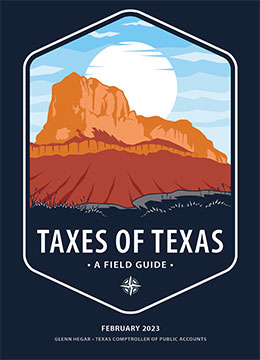Transparency at Texans’ Fingertips Texas Comptroller Provides Toolkit to Analyze Wealth of Data

The Regular Session of the 88th Texas Legislature is like no other in Texas history. Record state tax collections have contributed to a historic projected state budget balance. State legislators have a unique opportunity to use the money in ways that could have a lasting, positive impact on the people of Texas — and accurate, timely information is crucial to their success.
As policymakers work to make spending decisions and members of the public strive to keep up with the process and provide relevant input, the Texas Comptroller of Public Accounts offers a wealth of easily accessible information to help both groups dive into the intricacies of the state budget and crucial programs.
“By ensuring lawmakers and all Texans have the information they need at their fingertips as the state navigates complex revenue and spending issues, we can help empower them to make and support the best decisions for Texas,” says Comptroller Glenn Hegar.
The Comptroller’s office has numerous data-heavy responsibilities, including the high-profile, constitutionally required Biennial Revenue Estimate (BRE), which sets the parameters for the state budget before every regular legislative session. The agency also houses programs ranging from the State Energy Conservation Office (which partners with local governments and public institutions to reduce utility costs and maximize efficiency) to the Texas Broadband Development Office (tasked with establishing a long-term plan to expand access to broadband services for people across the state).
Each program, task and mandate assigned to the Comptroller’s office brings an abundance of data; the agency also is a repository of economic data from state and local entities. Ensuring Texans have access to reliable, downloadable and timely data from trusted sources so they can see how government spends their tax dollars is a tenet of the Texas Taxpayer Bill of Rights.
“While everyone has access to the same data that we use to help guide revenue estimates, our job is to make sense of the information and provide a trend line for the extremely complex Texas economy,” Hegar says. “When the data change, then it is our job to alert policymakers and the public that the direction of our economy is changing. Unfortunately, the job does not come with a crystal ball; rather, we spend a lot of time interpreting data that often come in the form of spreadsheets, graphs and charts.”
DIVING INTO GOVERNMENT FINANCE
Data visualization tools and databases allow users to view, download and analyze state government financial data from the Comptroller’s website, including a searchable database of statewide contracts; visualizations of key economic indicators, such as inflation; and data including the unemployment rate and lists of state grants.
In addition, the Monthly State Revenue Watch lays out revenue collections each month compared with the previous year, allowing people to compare recent unprecedented increases to historical data (Exhibit 1). It includes revenues like state sales tax collections, franchise tax collections and lottery proceeds on a cash basis.
EXHIBIT 1: ALL FUNDS HISTORICAL DATA, EXCLUDING TRUST, FISCAL 2003-2022
Source: Texas Comptroller of Public Accounts
DRILLING DOWN INTO STATE REVENUE AND EXPENDITURES
The Comptroller’s website offers many ways to see tax dollars at work. The State Revenue and Expenditures Dashboard, one of its most-viewed tools (Exhibit 2), has comprehensive reports and interactive tools with user-friendly data, graphics, visualizations and downloadable datasets. Information ranges from revenues and expenditures to payments (including travel payments) and spending on economic development.
Exhibit 2: FIVE MOST-VIEWED TRANSPARENCY PAGES, 2022
| WEBPAGE | PROVIDES |
|---|---|
| TAX ALLOCATIONS | Presents data on monthly local sales and use tax payments to local jurisdictions. |
| STATE SPENDING | Provides access to the Revenue and Expenditures Dashboard along with other tools and reports. |
| WEBFILE TRACKER | A real-time look at Webfile tax reports filed for a selected timeframe, updated every 15 minutes from 7 a.m. to 7 p.m. |
| DATABASES | Tools to help with researching taxable entities, accessing purchasing information, viewing economic indicators, recovering unclaimed property and more. |
| DATASETS | Raw, machine-readable, platform-independent datasets available through the Open Data Portal. |
Source: Texas Comptroller of Public Accounts
The revenue exploration tool has more than a decade’s worth of state revenue data for more than 25 state revenue categories, including sales taxes, motor fuels taxes and hotel occupancy taxes; all can be broken down by agency or appropriated funds. The expenditures tool allows comparison of 18 state spending categories.
The “payment to payee” tool lists individual payments, transaction dates, Comptroller object codes and more. State travel payments can be tracked by agency, individual payee and type of travel expense. Users also can explore economic development funds by fiscal year, fund name, agency or expenditure category.
FORECASTING REVENUE
The 100-page BRE is developed through months of research by Hegar’s expert staff, laying out the economic outlook in careful detail, providing historical perspective and illustrating items of current interest, such as effects of inflation and the projected balance in the Economic Stabilization Fund (ESF).
Complete copies of BREs published since 2005 are on the website, showing how much money was projected to come from particular funding sources and which dollars were committed before budget writing commenced. The BRE also tells Texans how much money is estimated to be set aside in the ESF for a rainy day and how much can be allocated for services.
After the state budget is final, the Comptroller releases the Certification Revenue Estimate (CRE), which provides the detailed basis by which the Comptroller certified the budget and any other bills making appropriations. It also revises estimates from the BRE to reflect legislative activity and provide updated economic information and forecasting.
Hegar has been adamant about keeping policymakers and the public informed about changes in the revenue picture. Each estimate may be updated as circumstances warrant; both original and updated documents are available online.
KEEPING AN EYE ON EXEMPTIONS
The Tax Exemptions and Tax Incidence Report estimates the value of each exemption, exclusion or other type of break available to those who pay taxes, ranging from sales to franchise to severance taxes. For fiscal 2023, the total value of these exemptions is estimated to be $78.03 billion. A significant share, however, is due to sales tax exemptions for items taxable under another law, such as insurance premiums and motor vehicle sales. And some exemptions are untouchable, as a practical matter, such as the exemption covering food for home consumption.
Through tax incidence analyses (prepared in accordance with Texas Government Code Section 403.0141), the report also seeks to identify those who ultimately bear the cost of each tax. When a tax is levied on businesses, for example, JoJo Estrada, an economist with the Comptroller’s office, says, “The ones who will ultimately pay the tax are people — consumers, in the form of higher prices for the product; business owners, in the form of lower profits; and workers, in the form of reduced wages.”
Estrada says this is especially important information for legislators.
“It serves as a tool to aid them in understanding the distributional effects of taxes on households and businesses,” he says.
PROVIDING A GUIDE TO THE TAXES OF TEXAS
Taxes of Texas: A Field Guide (PDF) shows a decade’s worth of information about how major taxes have contributed to state revenue. It first was published in 2015, and its layout since has been refined to make it easier to read.
“It’s a graphic-rich look and really handy way to get an overview of state revenue and the major taxes,” says Kaitlin Wetherbee, data analyst with the Comptroller’s Revenue Estimating Division.

The guide also has information about local property taxes; Wetherbee notes this includes data on the amount levied by each local taxing jurisdiction (school districts, counties, cities and special purpose districts), the average tax rate weighted by tax levy, the number of taxing entities that have reported to the Comptroller’s office and the maximum tax rates allowed by law. As the property tax is a local tax, which the Comptroller’s office does not collect, the agency relies on local taxing entities to report property tax information.
“It’s important for citizens to understand what taxes the state levies and where that money goes,” Wetherbee emphasizes. “I also hope legislators find the Field Guide useful as a quick way to access information while having discussions about legislation affecting taxes and revenue.”
The Field Guide is updated twice per biennium, shortly after the Comptroller’s office releases the BRE and the CRE. Wetherbee updates all data referencing Comptroller’s office resources, and she obtains some data from information published by other state agencies, including the Legislative Budget Board and Texas Education Agency.
REPORTING ON TEXAS’ FINANCIAL CONDITION: A TRADITION OF EXCELLENCE
In keeping with the requirements of the Governmental Accounting Standards Board, the State of Texas Annual Comprehensive Financial Report (ACFR) presents a picture of the state’s financial condition by combining the annual financial reports of all Texas state agencies and universities. The report provides the state’s taxpayers, customers, investors and creditors with a general overview of state finances and demonstrates accountability for the money it receives.
For the past 32 years, the Comptroller’s office has received the Certificate of Achievement for Excellence in Financial Reporting from the Government Finance Officers Association of the United States and Canada for the Texas ACFR. This is the highest form of recognition in governmental accounting and financial reporting.
“Preparing the ACFR is a major undertaking that begins soon after the prior report is published,” says Rob Coleman, Fiscal Management Division director, commending the division’s Financial Reporting section. “The team works many extra hours. Excellence is what the team strives for, and this award is a perfect example of the drive and dedication required to achieve that goal.”
Access to detailed financial information is just one step in transparency. It also is important that taxpayers understand the data and can navigate the websites, databases and documents that explain how their tax dollars are spent. This is why the Comptroller’s office publishes a Guide to Understanding Annual Comprehensive Financial Reports, which directs readers to useful information quickly. The guide also links to local government ACFRs for participating Texas local governments through the Transparency Stars program.
REPORTING ON REVENUE SOURCES
The Sources of Revenue report details decades of history and the current status of taxes and fees. Want to know the role of “sin taxes” in Texas throughout the decades? Wondering when Texas started taxing boats? This report provides perspective starting from 1972.
Unlike the BRE, the Sources of Revenue report is not required by the Texas Constitution.
“There is no hard due date for the report,” says Coleman. “But to make the publication useful for legislators and other interested parties, we try to publish it by the end of January every odd-numbered year,” when lawmakers meet in regular session.
The report provides legal citations, revenue history, rates and bases for specific revenue sources and other information giving a general idea of each revenue source’s place in the overall system.
DATA FOR THE TAKING
The Comptroller’s office is in the business of generating data. But being the keeper of those data also comes with a responsibility for transparency and commitment to accuracy owed to all Texans. The data are there for the taking, downloading and analyzing.
“I’m constantly getting calls and emails from lawmakers, the media or taxpayers who want more details about the state’s finances,” says Chris Bryan, director of the Communications and Information Services Division. “The response I get from folks when I show them the information readily available on our website is nothing short of amazement.” FN
This is only a start to the information available on the Texas economy. Explore our website for economic forecasts, original research on statewide economic matters, key economic indicators and more.
